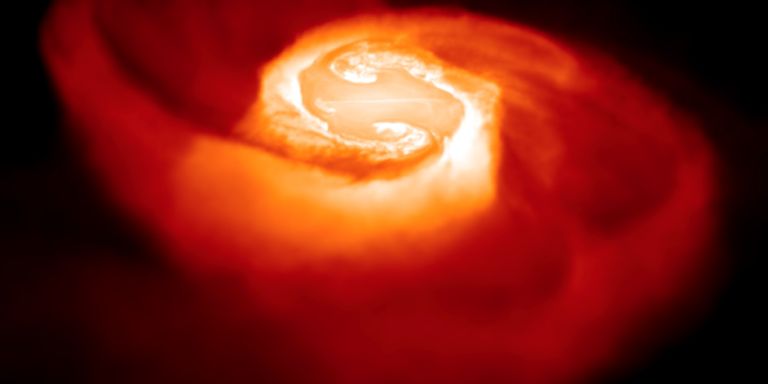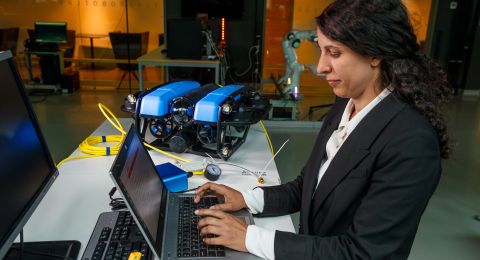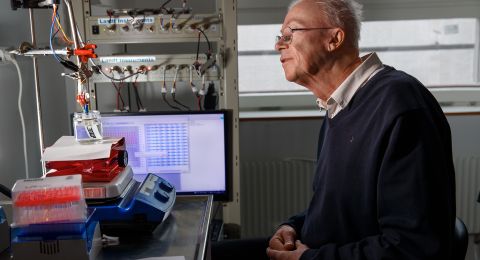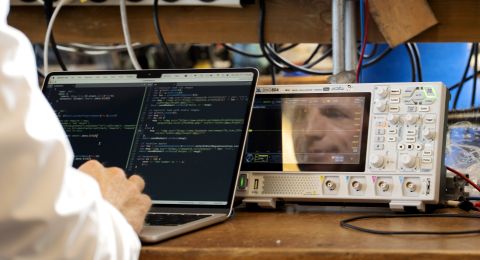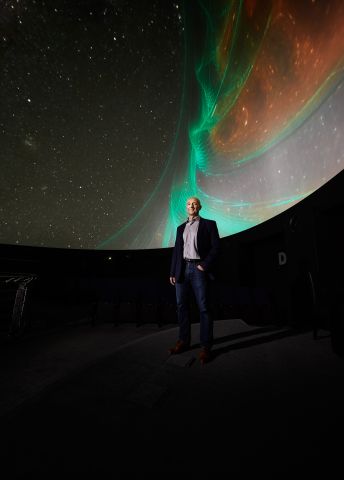
Project Grant 2019
Gravity meets light
Principal investigator:
Stephan Rosswog, Professor of Astronomy, focusing on extragalactic and high-energy astrophysics
Co-investigators:
Stockholm University
Ariel Goobar
Anders Jerkstrand
Hiranya Peiris
Jesper Sollerman
Institution:
Stockholm University
Grant in SEK:
SEK 33.5 million over five years
“This truly is physics under the most extreme conditions in the universe. It’s ten thousand times hotter than the sun, gravity is immensely powerful, and matter is packed more densely than in the nucleus of an atom. These facts alone make it exciting, and there’s so much else we want to find out,” exclaims Stephan Rosswog, professor of astronomy at Stockholm University.
There is no mistaking the enthusiasm with which Rosswog describes the cosmic events he and his fellow researchers are studying in a project funded by Knut and Alice Wallenberg Foundation.
Their research is focusing on collisions involving neutron stars. A neutron star is the ultra- dense collapsed core of an exploded star. They weigh about the same as our sun, but are a mere 20 kilometers across. Gravity at the surface of a neutron star is two hundred billion times stronger than that on Earth.
Brilliant crashes
Rosswog has studied neutron stars throughout his research career. He has used calculations and computer-based simulations to make predictions about what happens when two neutron stars collide.
The two stars accelerate toward one another, spiraling inward thereby generating gravitational waves, which spread out into space. Finally, the two stars crash into one another, combining to form a single neutron star which in many cases will finally collapse to a black hole. The collision produces copious quantities of radioactive matter, which is expelled into space, rendering the collision visible as a burst of electromagnetic radiation. A collision of this kind is called a kilonova or macronova.
As part of the project, the researchers intend to improve the theoretical models that predict what happens when neutron stars collide. They then hope to compare their findings with observations of real cosmic collisions.
“The project involves expertise covering the entire chain – from very fundamental physics to actually being able to observe these events in practice,” Rosswog says.
Making gold
The launching pad for the research is a breakthrough made in August 2017. For the first time astronomers were able to register both gravitational waves and electromagnetic radiation – as radio waves, visible light and gamma rays – from a single event in space. The subject of their attention was a collision between two neutron stars in a galaxy 130 million light-years from Earth.
The observations enabled the astronomers to check a number of theoretical predictions against real data, and yielded new knowledge on a number of unresolved questions. The researchers now hope that several cosmic events of this kind, which can be detected both by electromagnetic radiation and by gravitational waves, will shed light on questions that remain outstanding.
One such question, which is now being further studied in the project at Stockholm University, is how the heaviest elements on Earth were formed. Elements heavier than hydrogen and helium form inside stars. But extreme conditions are needed to create elements heavier than iron, such as gold and platinum.
It was long believed that these conditions existed in supernovas, which are exploding stars. But Rosswog’s computations enabled him to see that heavy elements are created and ejected into space when neutron stars collide. This was also confirmed in the collision detected in 2017.
“We’re now fairly sure that collisions between neutron stars creates heavy elements like gold. But there’s more to be learnt – like how large a proportion of the heavy elements they produce, and whether the pattern of particles formed varies from one type of collision to another.”
Research in the project is expected to yield new knowledge about how matter behaves under extreme conditions. But it may also tell us how fast the universe is expanding, by improving ways of measuring distances in space based on information from gravitational waves and electromagnetic radiation.
Scanning the night sky
A key element of the project is to improve the theoretical models that describe colliding neutron stars. Among other things, the researchers will be performing simulations over a longer time horizon, and endeavoring to better characterize the electromagnetic radiation that is generated. They will also be trying to include the elusive particles known as neutrinos in their calculations.
The theory will then be compared with actual observations. Astronomers are participating in the project. International collaboration gives them access to some of the most advanced telescopes in the world.
“A kilonova occurs over a period of hours, and gradually disappears after about a week. The astronomers scan the night sky looking for the flashes that reveal them.”
Roughly speaking, the astronomers hope to detect about ten collisions between neutron stars over the course of a year. But it is not certain they will see even one during the life of the project.
“Of course we hope we see what we expect to see, but we will need a little luck. But whatever we do see, I can almost guarantee it will be something exciting – something we can learn a great deal from,” Rosswog concludes.
Text Sara Nilsson
Translation Maxwell Arding
Photo Mascha Schepers, Bastian Werner
Multi-messenger astronomy
This form of astronomy involves studying an event in space with the help of information from more than one messenger.
A messenger might be electromagnetic radiation as visible light, gravitational waves, neutrinos or other particles. Together, the combination says more about the event than one type of messenger alone.
A breakthrough was made in 2017, when astronomers could for the first time detect both gravitational waves and electromagnetic radiation from the same event in space – a collision between two neutron stars.
